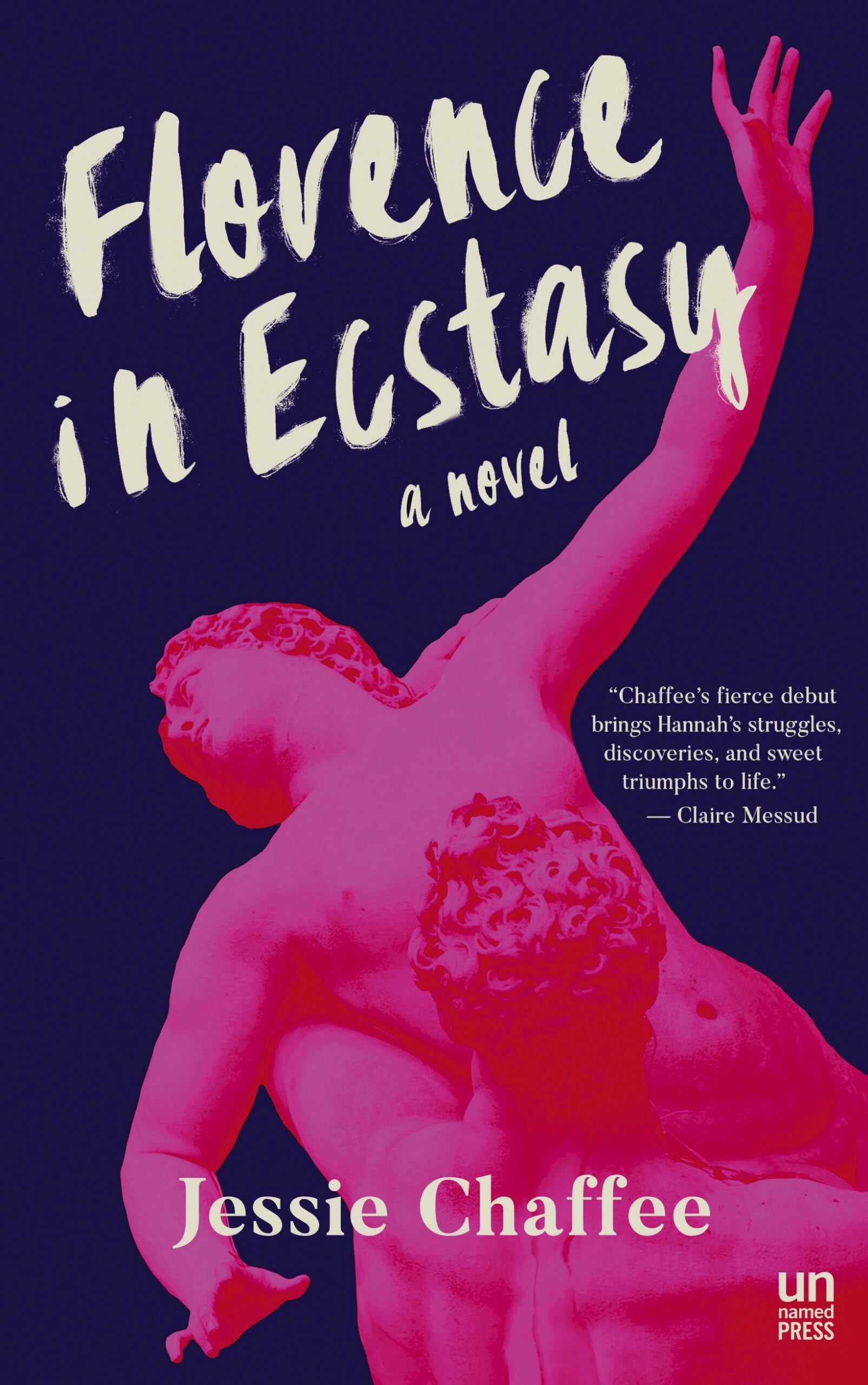Jessie Chaffee’s debut novel, Florence in Ecstasy, is out today from Unnamed Press. The book’s protagonist, Hannah, arrives in Florence from Boston, knowing no one and speaking little Italian. But she is isolated in a more profound way, estranged from her own identity after a bout with starvation that has left her life and body in ruins. She is determined to recover in Florence, a city saturated with beauty, vitality, and food―as well as a dangerous history of sainthood for women who starved themselves for God.
Hannah joins a local rowing club and is drawn into Florence’s vibrant present: soccer mania, eating, drinking, sex, an insatiable insistence on life. But Hannah is also rapt by the city’s past―the countless representations of beauty, the entrenched conflicts of politics and faith, and the lore of the mystical saints, women whose ecstatic searches for meaning through denial illuminate the seduction of her own struggles.
You can read an exclusive excerpt from Florence in Ecstasy here, and below, we talk with Jessie Chaffee about the process of writing the book over the course of a decade, understanding the world through writing, the role of mythology in the novel, and more.
***
The Rumpus: To start off, I’d love to hear about the process of writing this book. How long have you been working on it? How did you come to know and decide to write about Florence?
Jessie Chaffee: It will be almost a decade from when I began the novel to its publication. My relationship with Florence goes back further, though—I studied there in college, kept returning, and then received a Fulbright grant to live there for a year to complete the book. The book has taken twists and turns, but the core was always the same, and the setting was always Florence. I love Florence not only because it is a city filled with beauty and vitality and food—an appropriate and also complicating backdrop for my protagonist Hannah, who is struggling with an eating disorder—but it’s also a place where the past intermingles with the present in a way that is visceral, tangible, and completely unavoidable. Hannah encounters history everywhere she goes, including the history of the Catholic women mystical saints, whose stories help her begin to understand her own past.
Rumpus: The dialogue shifts between English and Italian, sometimes translated, mostly not. It gives the text such a beautiful and soft feeling. Do you speak Italian? How well? Can you talk about what it was like to use a non-native language in this way?
Chaffee: I wanted to include Italian in the novel both to convey the culture, which is so bound up in the language, and to enable to the reader to experience some of the disorientation and alienation Hannah feels as she struggles to understand and to be understood. There are also Italian words and phrases that are difficult to translate into English—sometimes because they are ambiguous, and that ambiguity makes for an interesting dynamic. So, for example, Luca refers to Hannah as “una donna particolare,” which can mean “a unique woman,” but also “a strange woman.” Hannah isn’t sure how he means it, and neither are we. I am semi-fluent in Italian, but it isn’t my native language, and so I had Italian friends read the book for linguistic—and also cultural—accuracy.
Rumpus: Art is central to the narrator’s experience not only of Florence, but of the world—she worked at a museum in Boston prior to moving to Italy. How would you describe the role of art in the text? What does it give Hannah?
Chaffee: In many ways, Hannah understands the world through art. Throughout the novel, she looks to art to make sense of her own emotional state. She finds in a painting in a museum in Boston the embodiment of her depression; she sees herself mirrored in frescoes of St. Catherine, who is depicted as both a stoic healing a possessed woman, and as a woman in ecstasy, seemingly possessed herself. Art is everywhere in Italy, and much of that art is about beauty and the body, both of which Hannah is struggling with. As she takes in the endless representations of women in churches and museums, it allowed me as a writer to explore her feelings about the bodies she is encountering and, by extension, her feelings about her own body. The art in the book is also a way of talking about the problems and complications of how women’s bodies are represented, understood (or misunderstood), and controlled.
Rumpus: What is your favorite work of art in Florence, and why?
Chaffee: My favorite piece of art in Florence is the sculpture that is on the cover, Giambologna’s The Rape of the Sabine Woman. A copy of it in is in the loggia in one of Florence’s main squares, Piazza della Signoria, so it’s impossible to miss. It’s depicts three figures—an old man being crushed under the foot of a young man who has, in his grip, a young woman, who is reaching up and trying to break free of him. The sculpture has an incredible sense of motion, the bodies circling and twisting until you arrive at its highest point, the young woman’s finger pointing upward. Hannah is drawn to the sculpture because of the woman’s gesture, which suggests that there is something beyond her entrapment. I’ve always loved the sculpture because it embodies, for me, the act of writing—of reaching for something that is just out of your grasp, of trying to capture the ineffable in words.
Rumpus: This idea of trying to capture the ineffable is a motif throughout the book; in fact, the excerpt you shared with us ends with the sentence, “There must be words for that moment.” What does it mean, as a writer, to be at a loss for words (or, at least, for one’s protagonist to be at a loss)?
Chaffee: I’ve always understood the world through writing, but arriving at that understanding is a long and indirect process of grasping for the right language, of circling around and back around. As Hannah experiences, trauma complicates this because it strips us of language; it makes the world incomprehensible. Hannah is desperate to understand what she’s been through, to put it into words. In moments like the end of this excerpt, she’s confident the words exist, but she doesn’t have them yet. It isn’t only trauma that leaves Hannah at a loss for words—the beauty, the history, the sense of connectedness that she finds in Florence also leaves her speechless, but in a way that is fulfilling, inspiring, and healing.
Rumpus: Your protagonist Hannah is struggling with anorexia, a disorder that is often romanticized, painted as the peak of asceticism and purity—even historically linked, as you discuss in the novel, to female saints. With this in mind, how did you approach writing about anorexia? Did you ever worry about romanticizing anorexia or thinness yourself?
Chaffee: The majority of the book occurs in the aftermath of the worst of Hannah’s experience with anorexia, and so the focus is on her attempt to extricate herself. It was very important to me that I not romanticize the eating disorder, but in those moments in which Hannah is recalling her experience, I did want to accurately portray the feeling of being inside the disorder, which, as I hope comes across, is both addictive and horrifying. And while the saints give Hannah a language for understanding her disorder—and she does, in many ways, connect with and even envy their ecstatic experiences—she also recognizes their behaviors as extreme and isolating. And ultimately her healing depends on rejecting part of what the saints represent.
Rumpus: At one point, Hannah says, “I was not a reliable source.” And it is true, her anorexia (and, early in the book, her drinking) makes her mind hazy, weak, confused. Would you say she is—or starts off as—an unreliable narrator?
Chaffee: I do see Hannah as an unreliable narrator in many ways. The anorexia takes a physical and mental toll, and, as with any addiction, when she is in the grips of it, she’s in an altered state—she says at one point that when she begins eating again, it’s like waking up to find someone else made war on her body and her life. She was a different person. So she recognizes that her sense of her past—and, when she’s not eating, her present—is distorted and filled with gaps and absences. But while Hannah might be unreliable when it comes to some of the events and details, her emotional experience—the representation of the disorder—is very real.
Rumpus: In the excerpt, there are a number of references to mythological women—the boat named Persefone and then the college students drawing Persephone, Medusa, a maenad. What is the role of mythology to the text? How is Hannah a Persephone figure?
Chaffee: I taught ancient history and literature for many years, and I’ve always been in interested in how people in the past tried to understand their world and make sense of it. Hannah’s crisis is physical but it is also existential, and I don’t know anyone who better captures the experience of looking into the void, of trying to make meaning from chaos, than the Greeks. Hannah is a Persephone figure in that she’s in Florence because she’s trying to recreate/rebuild herself after almost losing herself completely to the disorder. Part of saving herself involves descending into a kind of underworld—that underworld is the parts of her past that she doesn’t want to face, and it is also the rowing club, a kind of underworld in Florence that offers her the possibility of connection and survival and renewal.
Rumpus: At the start of the narrative, Hannah joins a rowing club. The excerpt depicts her first outing on the water in a scull. Why rowing? What is its significance to the story and to Hannah’s sense of self?
Chaffee: As Hannah feels when she’s first pushed out onto the Arno in the scull, rowing makes you profoundly vulnerable, and you can feel that vulnerability with every pull of water, with every breath. The only way to hold a straight course—and not tip over—is to be centered in your body and your mind. It’s a challenge for anyone, but especially for a woman who has been at war with and disconnected from her body. Rowing also requires balance, which is something that Hannah is searching for after living in physical and emotional extremes. And when on the water, there’s no way for Hannah to outrun herself—the river is where she continually comes face to face with herself and grapples with who she is, who she wants to be, who she’ll never be. The social life of the rowing club is also an important part of that exploration—the club is located directly under the Uffizi Gallery, one of the city’s tourist centers, but it is a different world, one dominated by Florentines. It is through the club that Hannah begins to connect with people in the city, including Luca, one of the rowers with whom she becomes involved. The vulnerability of being with another person physically and emotionally is important to Hannah’s survival. So both sculling and the rowing club itself are an opportunity for Hannah to find her way back to her body and herself.
***
Photograph of Jessie Chaffee by Heather Waraksa.





